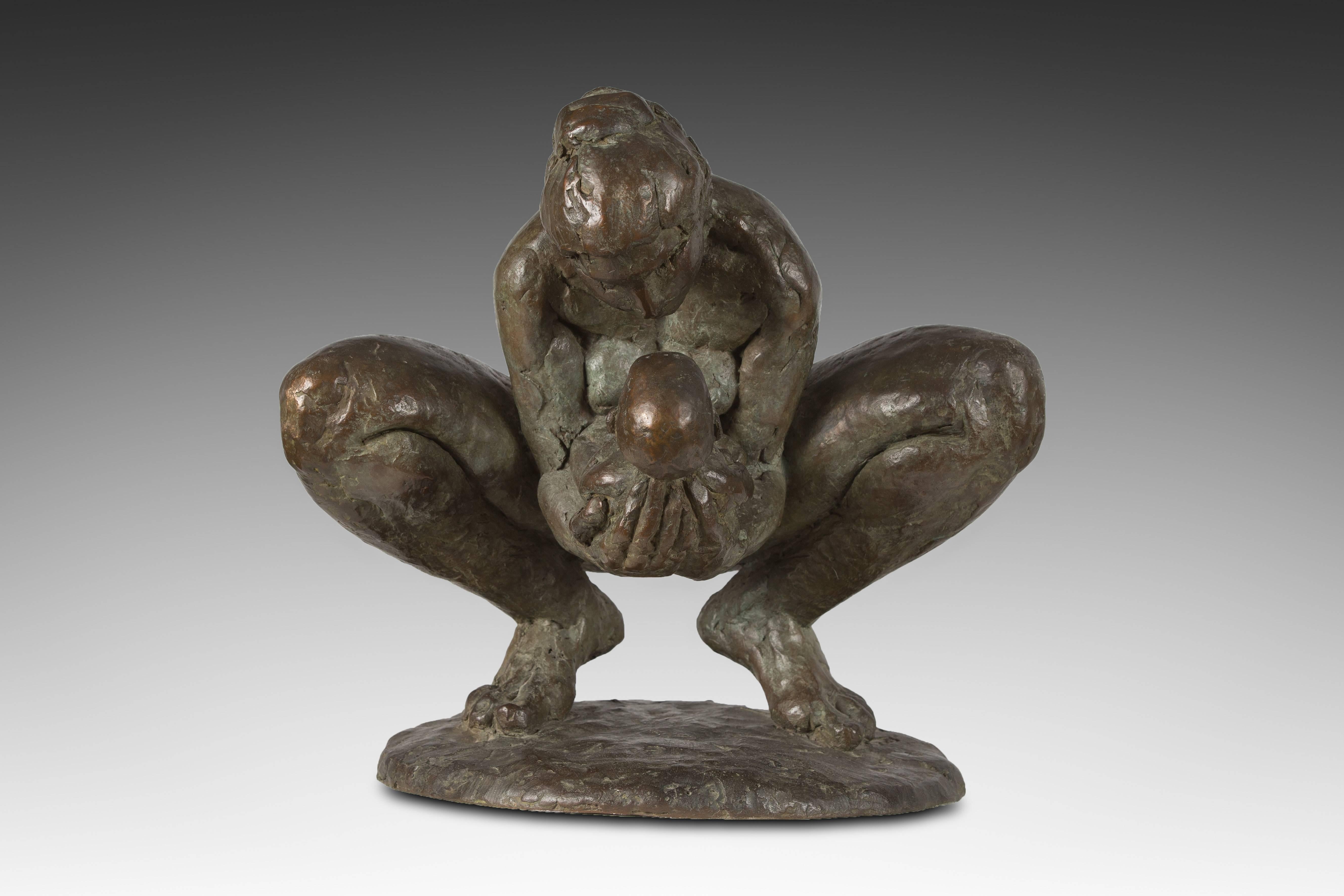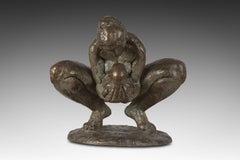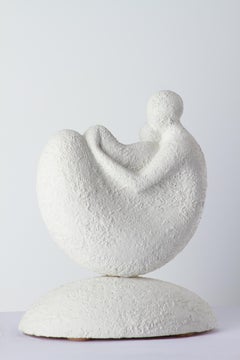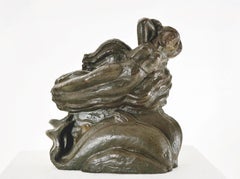Want more images or videos?
Request additional images or videos from the seller
1 of 10
Baltasar LoboThe Cradle1947
1947
$68,590.76
£50,781.38
€57,000
CA$94,968.71
A$103,683.10
CHF 54,356.81
MX$1,259,271.19
NOK 678,828.03
SEK 640,994.67
DKK 433,953.18
About the Item
Le Berceau (The Cradle)
by Baltasar LOBO (1910-1993)
A bronze group with a brownish green patina
Signed at the lower backside " Lobo "
Cast by " Susse Fondeur Paris " (with the foundry mark)
Numbered " 4/8 "
Bearing a label of the Galerie Daniel Malingue
France
Model created in 1947
Cast between 1986 and 1987
height : 19,8 cm
width : 32 cm
depth : 18 cm
Provenance :
- from the artist's workshop
- Galerie Daniel Malingue, Paris, 1988
- Collection Jacques and Michele Ginepro, Monaco.
Bibliography :
A similar model is reproduced in :
- "Lobo, marbres, pierre, bronzes. La mère et l'enfant" [oeuvres de 1946 a 1958], cat. exp. Villand & Galanis, Paris, 6 mars ‒ 15 avril 1970, n° 2.
- "Lobo", cat. exp. Caja de Ahorros, Zamora, 1984, n° 5.
- "Lobo", cat. exp. Galerie Daniel Malingue, Paris, 1988, n° 11.
- "Baltasar Lobo, Catálogo Razonado de esculturas", K. de Baranano, M. Jaume, M. L. Cardenas, Madrid, 2021, vol. I, pp. 222-223, n° 4701A et vol. II, pp. 222-23, n° 4701.
- "Baltasar Lobo : escultura en plenitud", J. del Campo, cat. exp., Cultural Cordon Caja de Burgos, 2017.
- " Lobo : Catalogue raisonné de l'œuvre sculpté", J-E. Muller, V. Bollmann-Muller, Paris, 1985, n° 61.
- "El silencio del escultor : Baltasar Lobo (1910-1993)", M. Bolanos, Valladolid, 2000, p. 172, n° 98.
- "Sculpture Passion", cat. exp. Salle des Arts du Sporting d’Hiver, Monaco, 24 mars ‒ 16 avril 1990, n° 223, p. 148.
Biography :
Baltasar Lobo (1910-1993) born in Cerecinos de Campos (near Zamora, Castilla) and dead in 1993 in Paris, was a Spanish sculptor of the new Paris School. His grandfather being a stonemason, from childhood Baltasar Lobo Casuero leart wood-working in the carpentry of his father. In 1922 he entered the studio of the sculptor Ramón Núñez in Valladolid as an apprentice where he sculpted wooden sculptures of saints for the processions. With a scholarship Lobo continued his training from 1927 at the School of Fine Arts in Madrid, which he considerd as a "cemetery" and he left after three months. His father then joined him in Madrid while he worked at the cemetery making reliefs and heads, and he attended the evening classes of the School of Arts and Crafts, specializing in the direct cutting of wood and marble. Baltasar Lobo then discovered the works of Picasso, Dali, Miró and Gargallo. In 1934 his wife Mercedes Comaposada Guillén, Lucía Sánchez Saornil and Amparo Poch y Gascón founded the journal of libertarian women's organization “Mujeres Libres”, to which he worked as a model and illustrator. Participating in the Spanish war in the Republican camp, his father was killed by a shell while digging trenches around Madrid. Most of his works being destroyed during bombings, Lobo fled in 1939 the Franco regime with survivors of the Catalan army, his wife leaving in the convoy of women. Escaped from the camp of Argelès, sleeping under the bridges of Perpignan, he managed to find her in a camp in thee Ardèche region.
When Baltasar Lobo arrived in Paris, he slept again under the bridges and at the Saint-Lazare station, joined by his wife. He went to see Picasso, who was not at home, left him a box of drawings, came back the next day and enjoyed his generous and friendly help. He could then settle in the studio that left Naum Gabo, binding with Henri Laurens and working some years in his garden the marbles that he received. His figuration was then simplified, in the spirit of the works of Constantin Brâncusi, Jean Arp, Henry Moore. Lobo developed an archaic character and continued to accentuate his non-figuration, around the themes of the female nude, Maternity and Bather, inspired by the drawings made, in a tower above the "Blue Flats", during his stays around 1945-1946 in La Ciotat where many Spaniards worked at the shipyard. He met there Brâncusi and the Spanish painters Tàpies, Parra, Xavier Oriach, Pelayo, Palazuelo.
Lobo exhibited in the 1950s and the 1960s at the Gallery Villand and Galanis (1957, 1962, 1964, 1966) near painters such as Chastel, Esteve, Gischia, Jacques Lagrange. A retrospective exhibition of Baltasar Lobo's work was presented in 1960 at the Museum of Modern Art in Madrid. Subsequently Lobo was appointed in 1981 an officer of Arts and Letters in France and received in 1984 the National Prize for Plastic Arts in Spain. Lobo realized in 1948 in Annecy a monument To the Spaniards dead for the Freedom, in 1953 a Maternity in bronze for the university city of Caracas and in 1983 in Zamora a Tribute to the poet Leon Felipe. He was credited with illustrations for "Platero and me" by Juan Ramón Jiménez. Lobo is buried in the Montparnasse Cemetery where one of his sculptures is placed on his grave (division 8, section 8). A "Baltasar Lobo Museum" presents in Zamora his work (33 sculptures, 18 drawings and many documents).
- Creator:Baltasar Lobo (1910 - 1993, Spanish)
- Creation Year:1947
- Dimensions:Height: 7.8 in (19.8 cm)Width: 12.6 in (32 cm)Depth: 7.09 in (18 cm)
- Medium:
- Movement & Style:
- Period:
- Condition:
- Gallery Location:PARIS, FR
- Reference Number:Seller: N.77781stDibs: LU2514215606662
Baltasar Lobo
Baltasar Lobo (1910-1993) born in Cerecinos de Campos (near Zamora, Castilla) and dead in 1993 in Paris, was a Spanish sculptor of the new Paris School. His grandfather being a stonemason, from childhood Baltasar Lobo Casuero leart wood-working in the carpentry of his father. In 1922 he entered the studio of the sculptor Ramón Núñez in Valladolid as an apprentice where he sculpted wooden sculptures of saints for the processions. With a scholarship Lobo continued his training from 1927 at the School of Fine Arts in Madrid, which he considerd as a "cemetery" and he left after three months. His father then joined him in Madrid while he worked at the cemetery making reliefs and heads, and he attended the evening classes of the School of Arts and Crafts, specializing in the direct cutting of wood and marble. Baltasar Lobo then discovered the works of Picasso, Dali, Miró and Gargallo. In 1934 his wife Mercedes Comaposada Guillén, Lucía Sánchez Saornil and Amparo Poch y Gascón founded the journal of libertarian women's organization “Mujeres Libres”, to which he worked as a model and illustrator. Participating in the Spanish war in the Republican camp, his father was killed by a shell while digging trenches around Madrid. Most of his works being destroyed during bombings, Lobo fled in 1939 the Franco regime with survivors of the Catalan army, his wife leaving in the convoy of women. Escaped from the camp of Argelès, sleeping under the bridges of Perpignan, he managed to find her in a camp in thee Ardèche region. When Baltasar Lobo arrived in Paris, he slept again under the bridges and at the Saint-Lazare station, joined by his wife. He went to see Picasso, who was not at home, left him a box of drawings, came back the next day and enjoyed his generous and friendly help. He could then settle in the studio that left Naum Gabo, binding with Henri Laurens and working some years in his garden the marbles that he received. His figuration was then simplified, in the spirit of the works of Constantin Brâncusi, Jean Arp, Henry Moore. Lobo developed an archaic character and continued to accentuate his non-figuration, around the themes of the female nude, Maternity and Bather, inspired by the drawings made, in a tower above the "Blue Flats", during his stays around 1945-1946 in La Ciotat where many Spaniards worked at the shipyard. He met there Brâncusi and the Spanish painters Tàpies, Parra, Xavier Oriach, Pelayo, Palazuelo. Lobo exhibited in the 1950s and the 1960s at the Gallery Villand and Galanis (1957, 1962, 1964, 1966) near painters such as Chastel, Esteve, Gischia, Jacques Lagrange. A retrospective exhibition of Baltasar Lobo's work was presented in 1960 at the Museum of Modern Art in Madrid. Subsequently Lobo was appointed in 1981 an officer of Arts and Letters in France and received in 1984 the National Prize for Plastic Arts in Spain.

About the Seller
5.0
Recognized Seller
These prestigious sellers are industry leaders and represent the highest echelon for item quality and design.
Established in 1992
1stDibs seller since 2023
10 sales on 1stDibs
Typical response time: 9 hours
- ShippingRetrieving quote...Shipping from: PARIS, France
- Return Policy
Authenticity Guarantee
In the unlikely event there’s an issue with an item’s authenticity, contact us within 1 year for a full refund. DetailsMoney-Back Guarantee
If your item is not as described, is damaged in transit, or does not arrive, contact us within 7 days for a full refund. Details24-Hour Cancellation
You have a 24-hour grace period in which to reconsider your purchase, with no questions asked.Vetted Professional Sellers
Our world-class sellers must adhere to strict standards for service and quality, maintaining the integrity of our listings.Price-Match Guarantee
If you find that a seller listed the same item for a lower price elsewhere, we’ll match it.Trusted Global Delivery
Our best-in-class carrier network provides specialized shipping options worldwide, including custom delivery.More From This Seller
View AllMotherhood
By Baltasar Lobo
Located in PARIS, FR
Motherhood
by Baltasar Lobo (1910-1993)
A bronze group with a nuanced greenish dark brown patina
Signed at the lower backside " Lobo "
Cast by " Susse Fondeur Paris " (with the foun...
Category
Mid-20th Century French School Figurative Sculptures
Materials
Bronze
Motherhood
By Baltasar Lobo
Located in PARIS, FR
Motherhood
by Baltasar LOBO (1910-1993)
A bronze group with a nuanced greenish dark brown patina
Signed " Lobo "
Cast by " Susse Fondeur Paris " (with the foundry mark)
Artist's cas...
Category
1940s French School Nude Sculptures
Materials
Bronze
Motherhood
By Baltasar Lobo
Located in PARIS, FR
Motherhood
by Baltasar LOBO (1910-1993)
A bronze group with a brownish green patina
Signed at the lower front " Lobo "
Cast by " Susse Fondeur Paris " (with the foundry mark)
Number...
Category
Mid-20th Century French School Figurative Sculptures
Materials
Bronze
Mother and Child, with a base
By Baltasar Lobo
Located in PARIS, FR
Mother and Child, with a base
by Baltasar LOBO (1910-1993)
A bronze group with a dark brownish green patina
Signed on the base " Lobo "
Cast by " Susse Fondeur Paris " (with the fou...
Category
Mid-20th Century French School Figurative Sculptures
Materials
Bronze
"Charity" also known as "Motherhood"
By Aimé-Jules Dalou
Located in PARIS, FR
"Charity"
also known as "Motherhood"
by Aimé-Jules DALOU (1838-1902)
A beautiful bronze group sculpture with a nuanced dark brown patina
Signed on the base "Dalou"
A very fine cas...
Category
Late 19th Century French School Figurative Sculptures
Materials
Bronze
Pensive à genoux
By Baltasar Lobo
Located in PARIS, FR
"Pensive à genoux, 2nd état"
by Baltasar LOBO (1910-1993)
A bronze sculpture with a brownish green patina
Signed on the base " Lobo "
Cast by " Susse Fondeur Paris " (with the found...
Category
20th Century French School Figurative Sculptures
Materials
Bronze
You May Also Like
Maternitè allongee (petite)
By Antoniucci Volti
Located in Villafranca Di Verona, IT
Numbered and limited to 8 copies
Artwork signed
Authenticity: Sold with certificate of Authenticity
Invoice from the gallery
Sculpture: bronze, metal, bronze patina
Display: The s...
Category
1960s Other Art Style Figurative Sculptures
Materials
Metal, Bronze
Le Jour by Cibot Bronze
By Elisabeth Cibot
Located in Pasadena, CA
Sculpture - original. Numbered 1/4. Founder GODAR.
Born in 1960 in a family of artists collecting the bronzes of the Italian Renaissance, sculpture has always been part of the en...
Category
1990s Contemporary Figurative Sculptures
Materials
Bronze
$9,600 Sale Price
33% Off
Mother & Child
Located in Knowle Lane, Cranleigh
The sculpture titled "Mother & Child" by Bettina Seitz beautifully captures the intimate bond between a caregiver and an infant through its elegant form. Crafted from a unique white ...
Category
2010s Contemporary Figurative Sculptures
Materials
Stone
Maqueta las toninas
Located in Miami, FL
Maqueta las Toninas, 1944
BMY-022, 1970
Edition 1/25
Bronze
22 x 22 x 10 cm
8.6 x 8.6 x 3.9 in
ABOUT THE ARTIST
Narvaez was born in Porlamar, Venezuela, in 1905; he was the fifth son of eleven siblings; his parents were Jose Lorenzo Narvaez and Vicenta Rivera. Don José Lorenzo, a multifaceted and creative man, sowed the seed of creativity in his son. “My father did not fit in with his fantasies of cabinetmaker, bricklayer, master builder, and self-taught architect.”1 From an early age, Francis was led to the artistic activity, he traced, carved, made replicas of the furniture and the saints restored by his father.
In 1920 he obtained his first professional assignment, a San Rafael for the Church of Carupano, and, in 1922, his father authorized him to travel to Caracas to pursue his studies as an artist. He studied at the atelier of Marcos Castillo, at of the Angel Cabre y Magriña and at the Academy of Fine Arts in Caracas, where he was introduced to the painters and intellectuals of the time.
In 1928 he presented his first solo exhibition at the Club Venezuela. With the money raised from the sale of the works and the support of Monsignor Sosa, and the Ministers Centeno Grau and Arcaya, he studied in Paris on a scholarship. Once there, he enrolled at the Académie Julian, where Tito Salas, Cristóbal Rojas and Arturo Michelena had also studied. It was in Paris where, unable to work in wood, he turned to stone carving. “In Paris, I didn’t have wood, so I carved a lot in stone (…), when there were demolitions I purchased chunks of stone, I would take them to the workshop and carve them.”2
His first attempts at volumetric sculptures and painting in plain colours, linked to the thematic of American miscegenation and Creole reality, can be traced back to that first trip to Paris. During his stay in the French city, Arturo Uslar Pietri, Alfredo Boulton, and Finita Vallenilla supported the artist both financially and logistically, and in February of 1930, the trio of friends arranged another exhibition for him at the Club Venezuela. Narvaez describes his exhibition as follows: “(…) in it I feel that the sculptural work is more my own, done with more assurance, a response to my pursuit of large planes, stylisation and synthesis.”3 By then, as Boulton himself noted in his book about the artist, Narvaez departed from most of the artistic traditions that prevailed by that time in Venezuela.
In 1931 he returned to Caracas and established his atelier at the Barrio Obrero in Catia. The atelier became the hub of the intellectual life of the time. “In those years, the atelier of Francisco Narvaez was the hub of the greatest Venezuelan hope. Nothing comparable to it can be found either before or since.”4
From that year onwards, exhibitions, projects, trips, and awards we multiplied. He was awarded the President of the Republic of Venezuela Prize, the National Sculpture Prize of the 1st Official Venezuelan Art Salon, and the John Boulton Prize of the 3rd Annual Venezuelan Art Salon; for the Military Academy, he produced a spectacular relief entitled La Patria.
In 1945, commissioned by the architect Carlos Raúl Villanueva, he produced two groups of sculptures known as Las Toninas, both located in the O’Leary Square. There, as he himself states, he incorporates some baroque patterns into the figures to the source itself: “It is a work of balance between the decorative requirements and the sculpture of planes and angles.”5
In 1948 he was awarded the National Painting Prize. In the same year, he was called upon by the architect Carlos Raul Villanueva to participate in the project for the arts integration in the Universidad Central de Venezuela. Francisco Narvaez’s public output continued with works such as the statue of Fermín Toro, La Educacion, La Ciencia, three murals (produced by María Luisa Tovar) for the Instituto de Medicina Experimental, El Cristo; el Atleta, the equestrian statue of General Rafael Urdaneta.
In 1953 he was appointed Director of the School of Plastic and Applied Arts, and in July of the same year, he exhibited “Francisco Narvaez, Maderas, Piedras y Bronces” (Francisco Narvaez, Woods, Stones and Bronzes) at the Museum of Fine Arts.
Narvaez is, unquestionably, one of the great Venezuelan sculptors, his work goes through various stages and interests; as the art world evolves, the artist does not remain in his initial scopes of work. His creations are not imposed by the prevailing trends or fashion but do evolve by experimenting with new materials and interests.
When one peruses the artist’s lengthy list of exhibitions, commissions, and awards, it is worth remembering the Narvaez who embark on his career as a child and who, overcoming obstacles, knew how to make the most of his curiosity. He did not settle for living off his successes. He did not remain stagnant as many creators of his environment did. Narvaez managed to understand the changes in the history of art around him. We must not overlook the fact that Francisco Narvaez is an artist amid all the changes occurring in the art world. He moves from the classics to the great transformations in the art world. It is the Europe of Picasso, Braque, Arp. He observes, he is aware of what is happening in the centres of the world of art, but between his craft and his sensitivity, the result is NARVAEZ, his stamp, and his identity.
Francisco Narvaez comes from tradition, and his first stage is linked to the classics, to the exploration of his heritage, but always with his very own language. Throughout his prolific career, he knew how to remain true to himself, without disregarding the influences of his surroundings or his artistic interests: his ability as a sculptor, his selection of materials, whether they were wood, stone or bronze; his choice of the subject of his work…His mastery and great craftsmanship are a constant that over time have made him a leading player in the history of contemporary Venezuelan and world art.
From his beginnings, no subject was foreign to him. His paintings, drawings, aquarelles, and sketches are testimony to his prolific output. Among his themes are portraits, our traditions, still lifes, and landscapes. Narvaez is an artist who represents his time. Later, he evolved towards purer and simpler forms, abandoning figurative art for short periods.
In 1956 he declared to the newspaper El Nacional: “Every day I am freeing myself, it is a soul that frees itself from the ephemeral wrappings of the circumstantial always, as well as from the inevitable weight of the anecdote. This second stage of my work is remarkably close to abstractionism, even if there are still certain figures or figurations in the sculptures that I will shortly be showing. However, pure, and absolute abstractionism, it will treat the form itself as the sole reason for its existence on the plane of artistic excellence.”6
The artistic development was his professional life. Each period of his life as an artist, he went one step further, searching, solving, seeing plenty of things and understanding how diverse expressions were transforming themselves. His hands followed his gaze and his mind, always inquisitive. He added movement to the volumes.
Arturo Uslar Pietri, “Formas Nuevas”, Cromotip editions, 1956 “Francisco Narvaez is a path: the path that Venezuelan sculpture...
Category
1940s Baroque Figurative Sculptures
Materials
Bronze
Maternity
By Patrick Brun
Located in Pasadena, CA
Patrick BRUN was born in Paris in 1941. After obtaining his Engineering degree, he began his professional life as a teacher in mathematics and physics. After this period, he started ...
Category
2010s Contemporary Figurative Sculptures
Materials
Bronze
$3,600 Sale Price
20% Off
LA FEMME ET LE CENTAURE
By Baltasar Lobo
Located in Aventura, FL
Cast in bronze in 1968 in an edition of 8. Wood base. Incised 'Lobo' with edition and foundry. From the edition of 8. Sculpture size not including base 5.25 x 6.25 x 4 inches.
Artw...
Category
1960s Contemporary Figurative Sculptures
Materials
Bronze
$28,000 Sale Price
20% Off
More Ways To Browse
Mid Century Cradle
Philip Mccracken
Picasso Ceramic Goat Plate
Posset Pot
R C Gorman Pottery
Ramirez Manuel
Rene Coutelle
Rennert Inner Dialogue
Resin Gummy Bear
Ricardo Mesa
Richard Macdonald Orpheus
Richard Macdonald Red Dress
Richard Macdonald Trumpeter Draped
Richard Orpheo
Riho Kuld
Rodin Man With Broken Nose
Rolling Ball Sculpture
Rosendo Porro Cuesta





